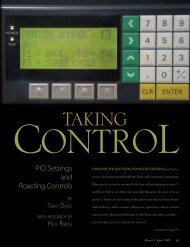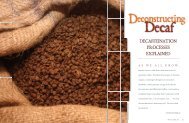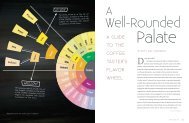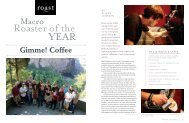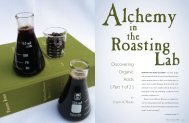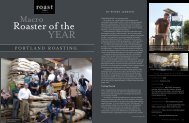In Hot Pursuit - Roast Magazine
In Hot Pursuit - Roast Magazine
In Hot Pursuit - Roast Magazine
You also want an ePaper? Increase the reach of your titles
YUMPU automatically turns print PDFs into web optimized ePapers that Google loves.
<strong>In</strong> <strong>Hot</strong><br />
What every business<br />
owner needs to know<br />
before purchasing a<br />
coffee roaster<br />
B y<br />
WILLEM BOOT<br />
<strong>Pursuit</strong><br />
Purchasing a roaster is one of<br />
the largest investments you will make<br />
in your coffee business. If planned<br />
well, the roaster acquisition can give<br />
you a longtime, loyal friend with<br />
countless shifts of valuable production<br />
hours. The reliability of a production<br />
machine is priceless.<br />
Yet businesses still tend to make<br />
common mistakes during the roaster<br />
selection process because they don’t<br />
ask the right questions. If you don’t<br />
prepare for the purchase with a<br />
proper plan, the consequences can<br />
be disastrous—such as purchasing<br />
a roaster and shipping it to your<br />
coffeehouse, only to discover that it’s<br />
too big to fit through the door.<br />
We all recognize the importance<br />
of doing due diligence prior to<br />
purchasing a house or a car, or<br />
deciding on an ideal location for a<br />
cafe. So why not set aside the time and<br />
resources to find the coffee roaster that<br />
will work best for your business and<br />
your budget?<br />
continued on page 22<br />
photo by Mike Love, Coffee Labs <strong>Roast</strong>ers<br />
20 roast September | October 2010 21
IN HOT PURSUIT: What Every Business Owner Needs to Know Before Purchasing a <strong>Roast</strong>er (continued)<br />
Planning the Purchase<br />
Those looking to buy a roaster must<br />
diligently prepare for the purchase by<br />
devoting sufficient time to inspecting<br />
different machines, using specific<br />
qualification criteria. If you want to<br />
prevent major post-purchase surprises,<br />
develop your own checklist of questions<br />
and issues that need to be addressed<br />
during the selection and procurement<br />
of a machine.<br />
It’s a daunting task to compare<br />
the specifications of all of the roasting<br />
systems on the market. Only a decade<br />
ago, the diversity of machines with<br />
smaller batch capacities was limited to<br />
less than 10 brands. Now, more than 20<br />
different manufacturers and suppliers<br />
have machines on the market, and this<br />
number is steadily increasing.<br />
This article doesn’t contain<br />
recommendations for certain machine<br />
brands or models. <strong>In</strong>stead, it outlines<br />
some clear guidelines and tips that can<br />
be indispensable during the buying<br />
process of your new or used roasting<br />
machine so you can develop your<br />
own proprietary requirements for the<br />
purchase.<br />
For the sake of keeping this article<br />
brief enough to fit in these pages, the<br />
article is geared toward those who are<br />
considering the purchase of a drum<br />
roaster. However, roasters who are<br />
looking into air- or wood-burning<br />
roasters can use many of the same tips<br />
to help make an educated decision.<br />
To discover which roaster is right<br />
for you, be prepared to ask lots of<br />
questions. Take the time to quiz roaster<br />
manufacturers, other roasters and, most<br />
importantly, yourself. Your questions<br />
will fall into three general categories:<br />
business, technical and practical.<br />
Know Thy Own Business<br />
Buying a roaster is a major investment.<br />
Unlike a t-shirt, you can’t take it back<br />
if you change your mind. Take a realistic look at your<br />
business and ask yourself some key questions.<br />
What size roaster will you require, and what is<br />
your budget? One roaster can be five times the cost of<br />
another. Once the roaster arrives, what is the cost to<br />
install it, and who will install it? Closer tech support<br />
means that you’ll have easier access to manufacturers.<br />
<strong>In</strong>vestigate additional equipment that you may<br />
need to buy to complement your roaster. A powerful<br />
roaster may require an equally impressive afterburner.<br />
Figure out how you will handle (and budget for) extra<br />
equipment before making a purchase.<br />
When budgeting, figure in the cost of maintenance<br />
and labor. If you need to replace a part on the roaster,<br />
procuring a spare part requires not only cash but<br />
also a slowdown (or worse, a complete standstill) in<br />
production. The length of time you can wait between<br />
ordering and receiving a spare part may steer you<br />
toward certain manufacturers.<br />
The answers to these questions will be unique<br />
to your situation, so take your time and make sure<br />
you are comfortable with your budget before you get<br />
serious about your hunt for a machine.<br />
continued on page 24<br />
BUSINESS QUESTIONS TO ASK<br />
u What size and type of a roaster do I need?<br />
u How much does the roaster cost?<br />
u If I outgrow it, what are my options?<br />
u How much will it cost to crate and ship the roaster?<br />
u How much will it cost to install?<br />
u Does the manufacturer have a warranty? If so, what<br />
is it?<br />
u Does the manufacturer have a reference list with<br />
roasters of a similar size?<br />
u Will I need any other equipment to operate this<br />
roaster (afterburner, loader, etc.)?<br />
u How much will it cost me to roast a batch of coffee<br />
(energy and labor)?<br />
u What are my options for financing the purchase?<br />
u What is my time frame? Some manufacturers take<br />
up to a year to fabricate a roaster.<br />
22 roast September | October 2010 23
IN HOT PURSUIT: What Every Business Owner Needs to Know Before Purchasing a <strong>Roast</strong>er (continued)<br />
Get Technical<br />
Next, you’ll need to consider the<br />
technical aspects of the machine.<br />
As a first step, ask the machine<br />
vendor for a technical diagram of<br />
the roaster. Make sure you’re talking<br />
to the right person. With smaller<br />
manufacturers, the chief engineer of the<br />
company often owns the business, and<br />
this would be the ideal person to speak with.<br />
The technical diagram generally shows<br />
the combined product flow and airflow of<br />
the roaster. It should list which motors are<br />
part of the system and how all parts are<br />
mechanically interconnected. Once you<br />
have the technical schematics, you’re ready<br />
to start asking about the specifics.<br />
Those considering purchasing a roaster<br />
should talk to other roasters—not only<br />
those who have dealt with certain<br />
manufacturers, but also those who roast<br />
or have roasted on similar machines.<br />
<strong>Roast</strong>ers generally are all too willing<br />
to discuss what delights and irritates<br />
them about certain machines, reveal<br />
modifications they have made (or<br />
been forced to make to overcome<br />
shortcomings or achieve desired results),<br />
talk about maintenance issues and<br />
discuss the difficulty or ease in repair<br />
or finding replacement parts. Ask them<br />
what they would do differently if they<br />
could do it over again.<br />
Some roasters may even be willing<br />
to let you run a few batches on their<br />
machines. Rather than relying solely on<br />
the testimony of a manufacturer, use<br />
other roasters as additional references to<br />
help make an informed decision.<br />
Let’s review a few key technical<br />
questions:<br />
Describe the unique benefits of<br />
this machine. Why did you choose<br />
this specific design?<br />
The best manufacturers know exactly<br />
how to answer this question. This<br />
doesn’t necessarily mean that their<br />
system is superior, but at least it<br />
provides proof of their knowledge of<br />
the roasting system. A good engineer<br />
will have a plausible explanation for the<br />
design choices that were made in the<br />
development of the machine. <strong>In</strong> addition<br />
to speaking with the manufacturer,<br />
the buyer should also seek out another<br />
roaster who is using one of the<br />
company’s machines. What are the pros<br />
and cons of the machine, from another<br />
roaster’s standpoint?<br />
How does the process of heat<br />
transfer differ from other brands?<br />
The issue of heat transfer is at the core of<br />
fundamental roasting discussions. Most<br />
roasting machines use three different<br />
types of heat transfer: convection,<br />
conduction and radiation.<br />
Convective heat is transferred by<br />
a continuous flow of preheated air. <strong>In</strong><br />
order to make this work, the roaster<br />
must have a roaster fan that moves the<br />
air along the burners and subsequently<br />
through the bed of coffee. <strong>In</strong>creasing<br />
the speed of the airflow can significantly<br />
shorten roasting times.<br />
The second type is conductive heat,<br />
which is transferred through the contact<br />
between the beans and the hot parts<br />
of the machine (the wall of the roaster<br />
drum and the veins of the roasting<br />
chamber). Some conductive heat also<br />
travels from bean to bean.<br />
The third type is radiant heat. The<br />
radiation is emitted by the heavy, hot<br />
parts of the machine, like the face plate.<br />
To accomplish a more gentle radiant<br />
heat, some manufacturers make these<br />
face plates from cast iron.<br />
Machines with relatively low airflow<br />
use more conductive heat transfer,<br />
though a roaster operator can increase<br />
conductivity by using slower relative<br />
drum speeds. Low-airflow roasters have<br />
the tendency to respond more slowly<br />
to changes in the applied heat. Simply<br />
stated, in this case it takes more time<br />
for the beans to register and react to the<br />
changed heat conditions. It’s important<br />
to test drive your candidate roasting<br />
machine to determine the roasting style<br />
you prefer.<br />
What is the maximum rated<br />
batch capacity?<br />
This is often a tricky question because<br />
batch capacity can hinge on several<br />
variables, including installation and<br />
roast level. Potential buyers should<br />
verify the actual required roasting time<br />
and actual capacity with someone who<br />
currently uses one of the roasters.<br />
What is the maximum roasting<br />
time per batch?<br />
<strong>Roast</strong>ing times longer than 20 minutes<br />
may produce baked flavors with a<br />
suppressed brightness and, at times,<br />
leathery aftertaste. Ideally, your<br />
candidate machine should have no<br />
problem completing a batch to the start<br />
of the second crack in 15 minutes or<br />
less. Most roasters can easily produce<br />
a faster roast, but keep in mind that<br />
defects such as scorching and tipping<br />
can occur when roasting beans too<br />
quickly.<br />
What is the airflow of the<br />
system?<br />
The airflow is generally expressed in<br />
cubic feet per minute (cfm). Airflow<br />
is important in a roaster for several<br />
reasons. Convective heat transfer occurs<br />
when hot air flows through the roaster.<br />
But after the beans have been roasted,<br />
good airflow enables the beans to stop<br />
roasting quickly once they’re emptied<br />
into the cooling tray. Without proper<br />
airflow in the cooling system, beans<br />
will not stop roasting immediately and<br />
can reach a darker roast level than the<br />
operator intended. Poor airflow can be<br />
caused by dirty machinery, installation<br />
problems or other machinery that creates a<br />
pressure problem in the roastery.<br />
The absolute rating of airflow is<br />
necessary to calculate the appropriate<br />
dimensions and design of an afterburner<br />
or other device for the cleaning of smoke<br />
and odors. Afterburner choice will also<br />
continued on page 26<br />
24 roast September | October 2010 25
IN HOT PURSUIT: What Every Business Owner Needs to Know Before Purchasing a <strong>Roast</strong>er (continued)<br />
affect airflow. Additional homework may be<br />
required to be certain of your airflow rates<br />
after final installation of the afterburner.<br />
How can I produce and repeat<br />
consistent roasting profiles?<br />
Ideally, the roaster should have two<br />
temperature-measurement points—one<br />
for the bean temperature and a second to<br />
measure the environmental temperature.<br />
On top of that, roasters should have some<br />
way of measuring the actual applied energy<br />
during the roasting process. Nowadays,<br />
various brands include a gas pressure gauge<br />
that measures the actual pressure between<br />
the main gas throttle and the burners. <strong>In</strong><br />
this configuration, this gauge is a good<br />
indication for the level of heat you’re using<br />
to roast.<br />
Creating consistent roasting profiles<br />
can be an arduous task if you have to<br />
manage without these tools. Make sure that<br />
your machine supplier provides detailed<br />
information on the merits of automated<br />
profiling data loggers as well as full profile<br />
control systems. Data loggers are used to<br />
compile the time and temperature data<br />
during the roasting process to assist the<br />
roaster operator in profile roasting, while<br />
a profile control system uses electronic<br />
process control hardware to manipulate<br />
the burner, airflow and drum rotation<br />
speed to produce consistent, repeatable<br />
roasts. Again, your best validation is to<br />
ask someone who uses the brand you’re<br />
looking into.<br />
What are the unique features of the<br />
drum design?<br />
Double-walled drums can help prevent<br />
scorching and tipping. Both of these<br />
roasting defects are undesirable as they can<br />
produce “off ” flavors in the cups.<br />
The drum’s interior design and how<br />
the air moves through the drum can<br />
also impact the beans’ heat absorption<br />
process. Some designs prohibit the beans<br />
from moving evenly throughout the<br />
drum, which can hinder the consistent<br />
development of flavor profiles. Ideally, the<br />
drum includes a set of mixing veins, which<br />
allow for a consistent multi-directional<br />
movement of the beans.<br />
Does the roaster have separate<br />
roasting and cooling blowers?<br />
If the roaster works with only one blower,<br />
then it’s generally impossible to roast and<br />
cool at the same time, which will definitely<br />
extend the cycle time per roast. Obviously, a<br />
dedicated fan will get the cooling task done<br />
much faster. For the sake of maintaining<br />
a consistent roasting performance, it’s<br />
important to regularly clean your machine’s<br />
interior system. <strong>Roast</strong>ers are prone to<br />
developing residues of roasting particles,<br />
oils, tar and dust. Over time, these residues<br />
will alter the performance of your machine,<br />
specifically due to the fact that the roasting<br />
fan gets clogged bit by bit, which will reduce<br />
its output and—as a consequence—the<br />
airflow though the roasting system. Verify<br />
what types of blowers are used and find<br />
out whether they, and other parts, can be<br />
replaced locally. Also, find out how you can<br />
get access to the roaster and cooler fans, and learn how to properly<br />
clean them.<br />
How long does the cooling take?<br />
Forget about how long it takes to cool the coffee to room<br />
temperature. The most important job of the cooling system is<br />
to halt the roasting process (see the question on airflow on page<br />
25). Extended cooling times may produce unnecessary loss of<br />
sweetness and undesirable bitter flavor notes.<br />
Is the machine UL-approved? If not, are the parts ULand<br />
AGA-listed?<br />
Buyers should ask this question to protect themselves from<br />
unforeseen surprises during the start-up phase.<br />
There are numerous cases of roaster operators who have<br />
been hurt by their own machines. Most common are “normal”<br />
occupational hazards like first-degree burns, which belong to the<br />
least serious category of accidents. Usually, there is enough time to<br />
respond if you accidentally touch the hot plate of the roaster, and<br />
more serious burns can easily be avoided.<br />
Other reported cases are much more serious; for example,<br />
when a finger or arm gets stuck near the moving parts of the<br />
cooler stirrer arm. If the machine isn’t equipped with an accessible<br />
emergency safety switch or clutch, this can potentially cause<br />
serious injury.<br />
TECHNICAL QUESTIONS TO ASK<br />
u How do I control the roaster?<br />
u Can I roast and cool at the same time<br />
(separate blowers)?<br />
u Why and how is your roaster different from<br />
your competitors’?<br />
u Do I want a drum roaster or an air roaster?<br />
Can you explain the difference?<br />
u What are the different control options for<br />
your machine?<br />
u What is your drum made from, and why?<br />
u What type of burner do you use, and why?<br />
What are the differences in the types of<br />
burners?<br />
u Is there a difference between natural gas and<br />
propane (LPG) in the quality of the coffee?<br />
<strong>In</strong>spectors can put your start-up on hold if there is insufficient<br />
proof that your roaster complies with the electrical and gas<br />
continued on page 28<br />
26 roast September | October 2010 27
IN HOT PURSUIT: What Every Business Owner Needs to Know Before Purchasing a <strong>Roast</strong>er (continued)<br />
certifications that may be required by local<br />
authorities.<br />
Also take into consideration your state’s<br />
regulated emission guidelines. If your<br />
machine does not meet the guidelines, you<br />
will not be allowed to install it.<br />
Lastly, talk with other roasters to<br />
determine what machines work best based<br />
on the cup profile that you would like for<br />
your coffee. Those buying a new roaster<br />
should ensure that the burner has the<br />
capacity to produce their desired roast<br />
style. If you already own a machine and are<br />
looking to purchase a second roaster, make<br />
sure your new one will produce a similar<br />
taste style.<br />
The Practical Perspective<br />
Admit it—you’ve impulsively purchased a<br />
cool new gadget just because you liked the<br />
color or design. Avoid making a rash choice<br />
on a roaster by sticking to your budget<br />
and your list of priorities. And ask a levelheaded<br />
friend to help talk through your<br />
options before you make a decision.<br />
Remember the adage “measure twice,<br />
cut once” when shopping for a roaster.<br />
Figure out whether you’ll be able to fit<br />
the roaster through the door of your<br />
coffeehouse or warehouse. Many otherwise<br />
intelligent roasters have neglected this<br />
step and suffered the embarrassing<br />
consequences. If you have a tight space,<br />
draw a map to show to manufacturers all<br />
of the hallways, turns and stairs that the<br />
machine will have to navigate to reach its<br />
new home.<br />
How about the ergonomics? <strong>Roast</strong>ing<br />
sessions can continue for many hours.<br />
During a production day, you and your<br />
machine should be able to collaborate in<br />
harmony. Ideally, the temperature displays<br />
and operational switches and handles<br />
should be located on one side. Preferably,<br />
the sampler should be mounted on this<br />
same side, and the sampler itself should<br />
be designed for a right- or left-handed<br />
operator.<br />
Did the manufacturer address the risk<br />
of back stress as a result of lifting heavy<br />
machine parts and green beans? How<br />
many times does the operator have to bend<br />
over during the operation cycle?<br />
Also consider how your machine will<br />
interact with its surroundings. Will the<br />
roaster interfere with traffic at your cafe<br />
PRACTICAL QUESTIONS TO ASK<br />
u Can I install it myself?<br />
u If I can’t install it, who can?<br />
u Do I need permits? From whom?<br />
u What is the impact of a roaster on my fire and liability insurance<br />
coverage and costs?<br />
u If renting a space, how will adding a roaster impact the rent? If my<br />
lease will be up soon, will I be able to find another space that will<br />
accommodate the roaster?<br />
u Do I need to season the drum?<br />
u How long will it take for me to feel confident in my finished<br />
product?<br />
u How long will it take for me to be consistent?<br />
u Do you offer training?<br />
u Do you offer start-up support?<br />
u Is the roaster difficult to maintain?<br />
u How do I get the roaster off the truck?<br />
u Will it fit through my cafe door?<br />
or warehouse? Measure where you’d like<br />
to situate the roaster, and then compare<br />
those numbers with the measurements<br />
of the roaster itself—do the math once,<br />
twice, even three times to make sure you’ve<br />
got it right. Don’t forget to consider the<br />
placement of your gas pipe. If it extends<br />
into the room, then your machine’s<br />
position will need to shift as well.<br />
Looking at the big picture, adding a<br />
roaster may involve a permitting process<br />
to make sure your system is set up to code.<br />
Talk with your insurance broker about any<br />
changes to the business’s fire and liability<br />
insurance, and discuss the roaster addition<br />
with your landlord—adding a machine<br />
may increase the landlord’s liability and<br />
could impact your rent.<br />
Create the<br />
Purchase Protocol<br />
Once you have done your initial<br />
homework, it’s time to get really serious<br />
by putting it all in writing. Establish a<br />
clear agreement with your supplier on<br />
the technical specifications of the roasting<br />
machine to minimize the chance of<br />
miscommunication.<br />
When it’s finally time to take delivery,<br />
inspect the machine at the supplier’s<br />
shop if you have the budget to visit the<br />
manufacturer. While you’re there, review<br />
step by step that all delivery criteria have<br />
been met. At this stage, it’s still relatively<br />
easy to make modifications on the machine.<br />
Once your machine has been installed in<br />
your shop, making technical changes will be<br />
much more challenging.<br />
Used and Rebuilt<br />
<strong>Roast</strong>ing Systems<br />
Let’s briefly discuss the selection and<br />
purchase criteria for a used or rebuilt roaster.<br />
Both options are usually, but not always, less<br />
expensive than purchasing a new roaster.<br />
Most new roasters come with a warranty<br />
and technical support, but you’ll probably<br />
be on your own if you buy used.<br />
Rebuilt roasters are typically older<br />
machines that have been disassembled,<br />
inspected and cleaned. Worn or faulty parts<br />
may have been replaced. Used roasters,<br />
on the other hand, are put up for sale in<br />
varying conditions. As with any fixer-upper<br />
projects, many used roasters will need some<br />
continued on page 30<br />
28 roast September | October 2010 29
IN HOT PURSUIT: What Every Business Owner Needs to Know Before Purchasing a <strong>Roast</strong>er (continued)<br />
elbow grease to get them looking and working their best.<br />
Purchasing a used or reconditioned roaster can be just as<br />
tricky as buying a used car. Never buy a machine that hasn’t been<br />
tested thoroughly before purchase, and always inquire with other<br />
roasting companies about the reputation of the vendor you are<br />
dealing with. Ideally, you should talk to the previous owner of the<br />
used machine. Those looking at a refurbished model should find<br />
and speak with the person who worked on the roaster to learn<br />
about what repairs were made.<br />
<strong>In</strong> the business of used roasters, not all vendors are<br />
knowledgeable about the actual process of coffee roasting or<br />
about developing roasting profiles. The better you do your<br />
homework, the less chance there of getting your hands burned on<br />
the purchase of a mediocre machine that was either improperly<br />
rebuilt or that is operationally unsafe.<br />
Buying Used or Rebuilt—<br />
Generic <strong>Roast</strong>er Checklist<br />
The following checklist was specifically developed for production<br />
roasters, and most questions can also be used for the majority of<br />
sample roasters.<br />
• Who is the seller? Did they actually roast with this machine?<br />
• What’s the history of the roaster? What year was it<br />
manufactured? (This can usually be found on the serial plate.)<br />
• Are there any signs of roaster fires? Check for a warped cooling<br />
screen or for other signs of charred components. <strong>In</strong> general,<br />
replacing a cooling screen can be a costly affair.<br />
• When was the last time this machine was serviced? Who did<br />
the work? Can this person be reached to discuss what repairs<br />
were made?<br />
• How is the general machine performance? Turn the machine<br />
on and listen for any unusual sounds. Locate the position of the<br />
roaster fan and the cooling fan. If you can inspect the fans, then<br />
open them and check the cleanliness<br />
of the fan housing. Does the roaster<br />
fan make a rattling sound? If so,<br />
then the bearings might be ready for<br />
replacement. Are the motors noisier<br />
than normal? If yes, then the bearings<br />
of the motor might need replacement,<br />
or the motor might need to be rewound.<br />
<strong>In</strong> most large cities, you can find shops<br />
that rebuild electric motors, but keep in<br />
mind it can often cost more to rebuild<br />
an electric motor than to purchase a<br />
new one.<br />
• Check the electrical specifications of the machine. European<br />
machines usually come as 220 volt at 50 cycles, while the<br />
conditions in the United States normally allow for 110 or 208 volt<br />
at 60 cycles. Due to the difference in cycles, the European motor<br />
will run 20 percent faster if used in the United States. Obviously,<br />
this will have an impact on the airflow and the drum’s revolutions<br />
per minute, which can affect the process of heat transfer and<br />
may even cause scorching and tipping. <strong>In</strong> addition, it can have<br />
a negative effect on the life of the motors and make parts more<br />
difficult to replace, as the mountings and shafts are metric, not<br />
standard.<br />
• Check the gas system of the machine. Does the gas installation<br />
have a safety valve? Under normal conditions, the machine must<br />
have a thermocouple that registers the presence of a flame after<br />
the burner is turned on. If for any reason the flame blows out, the<br />
sensor will immediately register the change in temperature and<br />
send a signal to the valve to turn off the gas flow.<br />
• Does the roaster have a safe electrical system?<br />
• Most importantly, can you test-roast with the machine? <strong>In</strong><br />
general, it’s risky to purchase a machine that you cannot test<br />
adequately. Visit the manufacturer or a nearby business that roasts<br />
with a similar machine, and roast at least two or three batches.<br />
Final Words<br />
Whether this roaster purchase is your first or your tenth, be assured<br />
that you will gain knowledge and become a more sophisticated<br />
buyer with each experience. Just remember to also use your palate<br />
while researching a roaster. Your roaster will likely become a<br />
longtime companion in your exciting quest for creating greattasting<br />
coffees. With this concept in mind, it’s essential to make the<br />
final choice for your machine on the cupping table.<br />
Willem Boot is president of Boot Coffee Consulting &<br />
Training, a company specializing in hands-on training courses for<br />
specialty coffee roasters. He can be reached at 415.380.1999 or at<br />
willemboot@bootcoffee.com.<br />
30 roast September | October 2010 31



